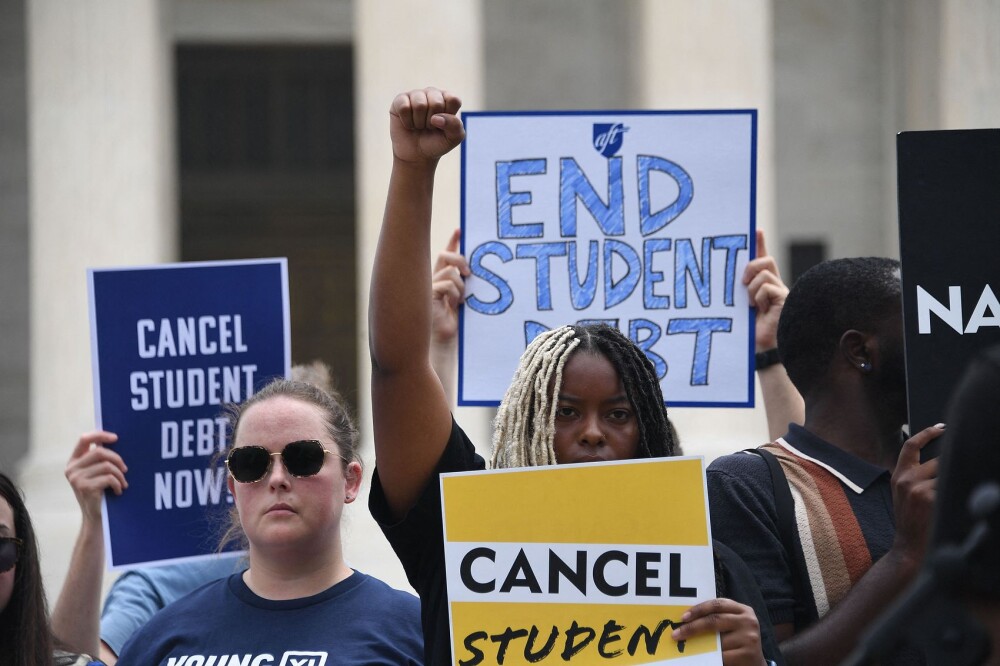
Supporters of student debt forgiveness demonstrate outside U.S. Supreme Court on June 30, 2023, in Washington, DC. (Photo: CFP)
Higher education in the United States has become an enduring struggle for millions of Americans, as student debt continues to weigh heavily on families across the country.
On May 5, the U.S. Department of Education resumed its use of compulsory measures to collect outstanding federal student loans. This move affects a staggering 42.7 million borrowers, who collectively owe over 1.6 trillion USD in student debt.
More than five million borrowers are already in default, placing them at risk of wage garnishment and reductions in Social Security benefits. Federal officials warn that, within a few months, the number of people in default could double to ten million.
Student debt has become a chronic social problem in the U.S., reaching deep into middle-class households and persisting across generations. Even former U.S. President Barack Obama, who was already a senator in his forties, did not finish repaying his student loans until 21 years after graduation.
Federal student loans account for 92 percent of all student debt in the United States, and default rates are now at record highs. This alarming trend has prompted renewed scrutiny of the systemic pitfalls that drive Americans into lifelong debt simply for pursuing higher education.
The escalating cost of a degree
In recent decades, the rising cost of tuition has been one of the primary drivers of America's student debt crisis. From 2009 to 2024, the average student loan debt surged by 63.1 percent, far outpacing the average household income in the United States.

Today, the average annual tuition and fees for a university student in the U.S. can reach 38,270 USD. For many families, this financial burden is overwhelming. For example, Kenyon College in Ohio charges an annual tuition of 66,490 USD, while the state's median household income in 2025 is projected to be 90,288 USD.
A survey by College Ave found that fewer than half (49 percent) of American parents are fully prepared to cover the total cost of their children's college education before enrollment.
Interest rates that trap borrowers in debt
High tuition is only part of the problem. The steep interest rates attached to student loans make them exceptionally difficult to repay.
For federal undergraduate loans being issued between July 1, 2024, and July 1, 2025, the fixed interest rate stands at 6.53 percent, according to the Federal Student Aid office. Private student loans can carry average interest rates of up to 17 percent, with even higher rates for graduate students.
These figures stand in stark contrast to Canada's interest-free student loans and Australia's system, where repayments are tied to the borrower's income and interest is effectively waived for low earners.
Worse still, the U.S. student loan system includes a mechanism for capitalizing unpaid interest. This means that when borrowers make only the minimum required payments, their loan balances continue to grow over time.
A growing sense of frustration
The economic and emotional toll of student debt has seeped into every corner of American society. CBS News has described the U.S. student loan system as "financial terrorism," while the 2011 Occupy Wall Street movement was partly fueled by outrage over student debt burdens.
Broader economic pressures, including the inflationary effects of ongoing trade wars, have exacerbated the problem. Rising living costs, coupled with stagnant wage growth, have left many Americans questioning whether a university degree is still worth the financial sacrifice. A Bankrate survey found that 56 percent of Americans believe college is too expensive, while nearly one-third (32 percent) see student loans as a national crisis.
Crucially, this crisis is not confined to the younger generation. More than three million older Americans continue to struggle with student debt well into their retirement years.
Lisa Jones, a 63-year-old with a doctoral degree and a successful career, still owes 77,000 USD in student loans. She diligently curtails her spending and avoids luxuries, knowing that debt will follow her into her later years.
The Trump administration's push to weaken the Department of Education has further undermined public trust. Proposals to curb access to loan forgiveness programs, including plans to scrap subsidized undergraduate loans and cap graduate and Parent PLUS loans, have fueled widespread concern over the future of student debt relief.
For many Americans, the student loan system epitomizes a government indifferent to public welfare. As one borrower put it: "We are angry not because we can't pay back, but because you set up this system that makes it impossible for us to do so, and then blame us for being lazy while cheering for the auto and banking industries."
Co-presented by GDToday and the School of Journalism and Communication, Jinan University
Reporter | Liu Xiaodi, Chen Sihan (intern), Peng Shengjie (intern)
Editor | Yuan Zixiang, James, Shen He

















